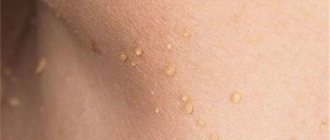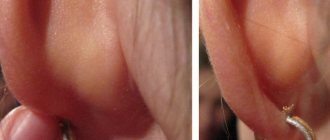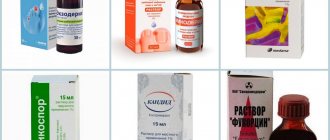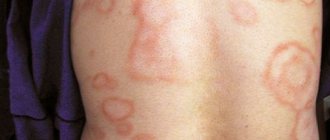A pressing problem in modern gynecology that many girls and young women face is papillomas on the labia. In these intimate areas on the mucous membrane from some types of HPV, the so-called appear. "genital warts". If a wart is detected or suspected in these places, each patient should know how the disease manifests itself, what treatment should be carried out and what tests should be taken for diagnosis.
These formations are very common. Warts on the labia minora and majora in girls are mainly represented by genital warts, the causative agents of which are types 6 and 11 of the virus. These types of HPV are of low oncogenic risk, that is, the risk of their degeneration into a malignant tumor is low. Children, teenage girls and girls with virgin status cannot be excluded from possible risk groups for the presence of these formations, because sexual is not the only way of transmitting the virus.
Condylomas and their types found in women
There are various options for classifying condylomas, including by quantitative characteristics and localization, but the main division is carried out in accordance with their appearance.
Based on this criterion, the following types of formations found in women are distinguished:
- Genital warts are the most common type that occurs when the papillomavirus is active; timely detection is difficult due to localization features and lack of pronounced color;
- Warty condylomas - have an external resemblance to vulgar warts and appear on the labia;
- Papular condylomas - appear simultaneously with small blisters filled with fluids; can occur in any part of the genital area;
- Microgrowths - appear in the initial stages of infection, are small in size and can disappear on their own with the normal functioning of the immune system;
- Endophytic or flat condylomas differ from other types by growing inside the tissue, which makes diagnosis difficult. This type is considered the most dangerous because it can provoke the development of malignant neoplasms;
- Typical condylomas have a pink or gray tint and are easily detected during a routine examination by a specialist.
Removal methods
Let's look at a detailed description of each removal method:
- Thermocoagulation.
Removal occurs by heating condylomas with high temperature. With this procedure, tumors on the mucous membrane or labia simply “burn off.” At the site of the growths, scabs remain, which become smaller and disappear literally after 3-5 days.
- Chemical destruction.
The method involves getting rid of genital warts by cauterizing the growths with a concentrated acid solution. Under the influence of the composition, the tissue that makes up the pathological growth is destroyed. The basis of the drug is nitric acid. In this case, the patient can purchase the drug at the pharmacy and treat it independently as needed. However, it is better if this is done by a medical specialist, since in practice many have become convinced of the ineffectiveness of these drugs. The acid concentration in the product for home use is much lower than in those used by professionals. The medicine used by doctors can remove formations in 2-3 sessions. After chemical destruction, virtually no traces remain.
- Removal by radio waves.
Surgery using radio waves is the safest and most effective in modern medicine. This method uses high-frequency radio waves, which are concentrated at the end of a special electrode. The waves are precisely directed to a specific area. In this way, the pathological growths are heated, causing them to collapse. The procedure is carried out under the influence of local painkillers. There is minor damage to the skin at the surgical site. A healing wound leaves no traces.
We recommend reading:
- What is lung lipoma
- Why do papillomas appear on the hands?
- Analogs of the drug Papilite
- Laser excision.
The method is characterized by exposure of the body of the condyloma to radiation from a special surgical laser. Its action has a destructive effect on tumor cells. The wound after removal is insignificant and heals quickly, leaving no small scars or scars.
- Cryodestruction.
The method involves cauterizing tumors with liquid nitrogen. If during thermocoagulation genital warts are affected by high temperatures, here, on the contrary, they are “frozen”. Low temperatures also destroy condyloma tissue. This method is considered the most accessible and inexpensive.
All of the above removal methods are performed exclusively by professional specialists in medical offices using painkillers or local anesthesia.
What is genital warts in women?
Condylomas that appear on the labia of women are overgrown epithelium in the form of an outgrowth. With the growth and development of education, a person is not contagious, but after these processes are completed, the risk of infecting other people increases sharply.
In women, the appearance and development of genital warts does not occur the same way as in men, since not only the external parts of the genital organs are affected, but also the cervix.
Only a gynecologist can detect formations in such a localization during an examination.
Where are genital warts located in women?
Genital warts in women can be localized in the following places:
- Labia;
- Cervix;
- Internal areas of the vagina;
- Anus and areas around it;
- The area near the entrance to the vagina;
- Mucous membranes of the oral cavity;
- Rectum;
- Urethral canals.
Most often, condylomas are located in the labia, urethra, vagina and cervix.
Reasons for the appearance of genital warts on the labia of a woman
The reason for the appearance of genital warts on the labia is the transition of the human papillomavirus, which may be present in the body and not manifest itself for a long time, into the active phase.
This process can be triggered by the following factors:
- Deterioration of the immune system , due to which the body cannot independently cope with the activity of HPV;
- Promiscuous sexual activity and failure to comply with personal hygiene rules;
- Lack of adequate and balanced nutrition , prolonged fasting, grueling dietary practices;
- Oncological diseases and exacerbation of chronic diseases;
- Hormonal imbalances in the body , as well as endocrine changes;
- Pregnancy and changes occurring during a given period of time;
- Frequent respiratory diseases that negatively affect the body's protective functions.
People with strong immunity can be carriers of this virus all their lives, but never get sick.
Symptoms of the disease
Condylomas on the genitals and in the perineal area can cause a number of characteristic symptoms. The main one is the appearance of small growths (neoplasms), which can be either flat or pointed. Condylomas usually do not exceed 4-5 mm in size, however, if the disease progresses quickly, the neoplasms can quickly increase to a fairly large size (3-5 cm) and merge with each other, forming plaques. You can learn more specifically about condylomas in men in this article.
The color of condylomas depends on the individual characteristics of the organism and can vary from pale pink to dark brown. The number of tumors also differs in each individual case. In some cases, in addition to the formation of condylomas, the disease may be accompanied by symptoms such as burning, pain, and discomfort during urination or sexual intercourse.
Condylomas themselves are not dangerous to humans, but they can lead to the development of severe complications. One of them happens quite often - when rubbing against underwear, condylomas can be injured, in which case severe bleeding occurs. If condylomatosis is not treated for a long time, the neoplasm can transform from a benign form to a malignant one. In such cases, cancer occurs - a disease that is much more difficult to cure. In order to reduce the likelihood of such consequences, experts recommend promptly seeking medical help.
How does infection occur?
The human papillomavirus, which causes the appearance of genital warts on the labia, can enter the body in the following ways:
- Unprotected sexual contact is the most common route of infection. In the presence of oral-genital and anogenital contacts, there is also a high risk of transmission of the virus;
- Household route – the risk of infection is less than through sexual contact. Transmission of the virus usually occurs through towels, linens, and personal hygiene items used by a person with HPV;
- Vertical route of infection , in which transmission of the virus occurs during childbirth if there are genital warts on the surface of the birth canal.
Removal
If the use of prescribed medications does not bring the desired effect, the use of hardware and surgical methods is required. Only a doctor can remove growths on the labia and vaginal mucosa, since these areas are easily damaged, which will worsen the patient’s condition several times.
| Methodology | Technique |
| Surgical removal | Used only in large areas and the presence of malignant neoplasms. The operation requires general anesthesia and a month-long recovery period. |
| Cauterization with liquid nitrogen (cryodestruction) | Liquid nitrogen is applied to the condyloma, which quickly removes it. The session lasts 10 minutes, local anesthesia can be used. It takes two weeks to heal and sometimes leaves scars. |
| Laser | During the procedure, the laser directly affects the lesion. Due to the high temperature, it dries out and falls off. More often used for extensive lesions. |
| Electrocoagulation | Also used for complex patient conditions. During the procedure, the areas are burned with electric current, and anesthesia may be required. |
| Radiosurgery | A very effective and fast method for removing condylomas on any area of the skin. A completely painless appointment, all growths can be removed in one visit. An expensive method in which a high-frequency wave is applied to the lesion, causing the death of pathological tissues. |
If, after removal, the treated areas of the mucous membrane and skin become swollen, you need to consult a doctor. A dermatologist will evaluate the condition of the labia and prescribe an anti-inflammatory drug. Ointments Triderm, Pimafucin, Vagilak can help cope with swelling and soreness. They also have a beneficial effect on the vaginal microflora, protecting against dysbacteriosis, redness, itching and burning.
Symptoms of appearance on the labia
The average incubation period is 8 months, but it can last for years.
At the initial stage, when the virus is activated and formations begin to develop, the following symptoms occur:
- Itching and burning in the anus and genital area - the discomfort is usually mild and goes away on its own within 4-6 hours;
- The appearance of small blisters that do not differ in color from the skin and mucous membranes.
With the further development of the disease, the following processes occur:
- The appearance of formations , the size of which gradually increases. Usually, several condylomas appear in one area at once;
- Fusion of emerging condylomas;
- Pain sensations occur only if localized on the cervix or internal surfaces of the vagina;
- Bleeding after sexual intercourse , the appearance of an unpleasant odor and sanguineous discharge are symptoms indicating mechanical damage to genital warts;
- Disappearance of physical discomfort after growth has stopped and condylomas have firmly established themselves on the labia.
Genital warts on the labia can be distinguished from other formations by their characteristic appearance, which is described below:
- Small size , usually does not exceed a few millimeters.
- Lumpy structure , giving an external resemblance to cauliflower.
- The presence of a thread-like leg attached to a wide base.
- Pink or red color or shade identical to the skin.
Flat condylomas have the shape of a bed; they are more difficult to detect without the use of special diagnostics if they are located on the cervix.
Symptoms
After infection with HPV, it may take several years for the first genital warts to appear. Often the infection occurs without symptoms, so it is impossible to confirm HPV infection without a laboratory test.
Symptoms of the development of viral warts:
- at the initial stage - redness of the skin, small rash;
- the appearance of flat warts on the mucous membranes of the genital organs;
- discomfort during sex (pain, itching, burning);
- the appearance of erosions and cracks in the genital area;
- change in skin color of the perineum, hyperemia;
- the appearance of single papillae on a filiform stalk.
After the first condylomas appear, the disease can develop according to the following scenarios:
- self-healing after restoration of immunity (extremely rare);
- active reproduction of warts;
- stable remission (the number and size of formations are unchanged);
- malignant transformation.
Any of these symptoms is a good reason for urgent consultation with a gynecologist and venereologist.
What is the danger of appearance on the labia and possible complications?
In most cases, condylomas on the labia only negatively affect aesthetics and do not pose a serious threat to health. A certain risk is associated with infection of other people or degeneration into malignant tumors.
This can happen under the influence of the following factors:
- AIDS;
- HIV;
- Systematic mechanical impact or friction;
- Excessive physical activity;
- Frequent stress and emotional stress;
- Localization in the cervical canal.
Symptoms that indicate possible complications and require immediate contact with a specialist are as follows:
- Change in color of condyloma acuminatum;
- Increase in size after the cessation of active growth of the formation;
- The appearance of physical discomfort and pain, regardless of their severity;
- Tendency to bleeding;
- The appearance of an unpleasant putrid odor.
Symptoms of condylomatosis
Condylomas on the head of the penis
During unprotected sex with a man who is a carrier of the papilloma virus, the woman becomes 100% infected. At the same time, a man becomes infected less often from a woman.
In men, condylomas most often occur on the coronary sulcus of the genital organ, near the opening of the urinary canal, in the area of the anus and on the scrotum.
In women, growths are found on the genitals, near the anus, in the perineum, in skin folds, in the armpits, near the navel, in the lower part of the mammary glands.
Condylomatosis is equally common among men and women; it is rare, but can develop in children and the elderly.
The pathology begins with the development of small papillary-shaped formations, resembling growths, pinkish in color.
Related article:
What are the causes and how to remove papillomas under the arms?
Over time, the new growths grow and unite into groups; they can resemble cauliflower inflorescences, which are located on a thin stalk.
Symptoms of the acute phase of condylomatosis:
- Burning;
- Itching;
- Painful sensations during physical activity, sexual intercourse;
- If neoplasms are located in the urethra and anus, problems with urination and bowel movements may occur.
Depending on the duration of the disease, the growths may change color - they become dark red, brown, and erosions occur.
When palpated, condylomas can be painful, and if damaged, they bleed.
Serous discharge with a rather unpleasant odor may accumulate between the growths.
Important! Advanced forms of condylomatosis can degenerate into malignant formations. That is why early diagnosis of pathology is necessary.
Diagnosis of condyloma on the labia
Diagnosis carried out by a gynecologist is aimed at excluding syphilis, inflammation of the follicles and angiokeratoma in a woman, since they have similar clinical manifestations.
The set of measures includes the following methods:
- Visual examination to detect genital warts;
- Colposcopy is a more informative technique that allows you to determine the presence of complications;
- PCR analysis - necessary to determine the type of virus that provoked the appearance of condylomas; the information obtained also allows one to assess the risk of developing malignant tumors;
- Biopsy is performed only if cancer is suspected.
Condylomas can simultaneously affect the labia and other adjacent areas, therefore, if necessary, anoscopy and urocystoscopy are prescribed.
Methods for removing genital warts on the labia in women
In fact, it is always recommended to remove genital warts that appear on the labia. Depending on their location, stage, quantity and size, the specialist selects the most suitable method.
All removal techniques that are practiced today are discussed in detail below.
Cryodestruction with liquid nitrogen
Liquid nitrogen is used to carry out cryodestruction - a procedure in which the destruction of condyloma is carried out under the influence of low temperature conditions.
The following positive features of this option for removing formations are highlighted:
- No pain or other physical discomfort , so no prior anesthesia is required;
- Absence of scars after cryodestruction , if the procedure was carried out efficiently and healthy areas of tissue were not damaged;
- The rehabilitation period depends on the size and number of removed formations , but recovery is quick.
If there are a large number of formations on the labia, cryodestruction is carried out in several stages; between procedures there must be a break of at least 7 days.
Electrocoagulation
Electrocoagulation is another way to remove genital warts using special equipment.
The procedure itself looks like this:
- Initially, pain relief is carried out , novocaine is most often used;
- Condylomas are excised and burned using a special electric knife;
- Instant cauterization ensures no bleeding.
Electrocoagulation has recently been practiced much less frequently due to the complexity of the procedure, long-term rehabilitation, which takes about 3 weeks, and the persistence of scars after the sores disappear.
It is gradually being replaced by laser removal, which does not have such disadvantages.
Laser removal
Removing condylomas on the labia using a laser is a more modern way to solve the problem.
The treatment regimen is as follows:
- Preliminary anesthesia , by general anesthesia;
- Destruction of condyloma with a laser beam without direct contact and tissue damage;
- During removal of the formation, the bacterial microflora is simultaneously destroyed , the place is cauterized, so there is no bleeding. The duration of all manipulations takes no more than 20 minutes;
- The depth and area of radiation is manually adjusted by a specialist depending on the affected area;
- After 2-4 weeks, the specialist may schedule a follow-up visit if another session is required. The need for this arises only in advanced cases, when the formations have time to grow significantly.
The main advantage of removing genital warts with a laser is the absence of a rehabilitation period and negative consequences after the operation. There is a risk of scarring, but this likelihood is minimal.
Radio wave method or Surgitron apparatus
The use of high-frequency radio waves is considered one of the safest destructive ways to get rid of genital warts on the labia.
The procedure can be divided into three main stages:
- Treatment with local anesthetic;
- Using a special device with an electrode that allows directed exposure to radio waves;
- Heating of the formation , leading to the destruction of its tissues.
The American Surgitron device is often used for radio wave removal of condylomas.
Its use during the procedure provides the following advantages:
- No significant impact on adjacent tissues;
- Fast implementation and recovery, rehabilitation takes only 1.5-2 weeks;
- Ensuring good cosmetic results, absence of scars;
- No bleeding or open wounds through which infection can enter.
Removal with a scalpel
Surgical excision of condylomas on the labia using a scalpel is an outdated method of removing them. Today, it is practiced only in the presence of large formations for which it is impossible to apply other techniques.
The operation includes the following steps:
- Local anesthesia;
- Excision of formations using a scalpel;
- Stitching;
- Mandatory antiseptic treatment, since there is a risk of infection in an open wound;
- Removing stitches.
Recovery after such removal of condylomas can take from 2 to 4 weeks; during rehabilitation, bleeding, infection, mild inflammation and pain may occur. After the operation, scars remain.
Is it necessary to remove condylomas?
Such tumors can cause a lot of inconvenience - getting caught in clothing and getting injured during sex. For this reason, all doctors try to prescribe removal of growths at an early stage.
What methods exist:
- Laser removal of condylomas
Laser. The growth cells are destroyed. The good thing about this method is that it makes it possible to both remove the tumor and stop the bleeding; - Radio knife. With the help of a narrow, targeted beam of high-frequency waves, condylomas are eliminated. The method is bloodless and minimally invasive;
- Electrocoagulation. The formations are cauterized with a hot metal loop of high temperature, which specifically affects the condylomas. During manipulation, patients may feel a little pain, but this pain is short-lived;
- Chemical removal. Burning out condylomas using chemicals, usually fluorouracil, trichloroacetic acid. The chemical drug has a targeted effect on pathologically altered cells;
- Cryodestruction. Freezing condylomas with liquid nitrogen. With the help of low temperatures, pathogenic cells are easily destroyed. This method is good for removing single formations, which begin to heal after 2 weeks;
Cryodestruction
- Interferon therapy. The human papillomavirus is destroyed naturally, under the influence of immune cells, this is a non-invasive and bloodless method;
- Surgical interventions using a scalpel are used quite rarely, since the manipulation is invasive and there is a possibility of bleeding. It is mainly carried out in advanced cases when several growths are connected.
During pregnancy, it is not recommended to remove condylomas, except in cases where they are in the vagina, on the cervix and interfere with their growth.
The choice of a specific method depends entirely on the number of growths, their volumes, and location.
Video about treatment of condylomas in pregnant women and children
Treatment of genital warts on the labia
Treatment of the disease requires an integrated approach, therefore, even with successful removal of formations from the labia, drug therapy is prescribed.
Antiviral drugs
The basis of drug therapy is antiviral drugs, the action of which is aimed at suppressing the activity and stopping the reproduction of the causative agent of the disease.
The most effective modern drugs belonging to this group include the following drugs:
- Alpizarin is available in the form of tablets containing 100 mg of mangiferin. The dosage regimen is determined by the doctor individually; it is allowed to take from 3 to 8 tablets per day; the course ranges from several days to a month, depending on the stage of the disease and the area of the lesion. Pregnancy is a direct contraindication for taking Alpizarin. A package of 20 tablets costs 180 rubles ;
- Cycloferon is often used in the treatment of genital warts with any localization, since the drug has a combined effect: it simultaneously affects the DNA of the virus, stopping its reproduction, and stimulates the activity of the woman’s immune system. The active substance is methylglucamine acridone acetate; use is prohibited in the presence of acute diseases of the digestive system. The daily dosage, frequency of administration and duration of the course are determined by the doctor individually. The cost of a package containing 20 tablets is 350 rubles .
Alpizarin Cycloferon
Immunostimulants
Another important component of drug therapy are immunostimulants, since the appearance of genital warts indicates a dysfunction of the immune system. These drugs restore the body's defenses, preventing relapses of the disease.
Examples of medications prescribed by specialists are given below:
- Lykopid are tablets containing glucosaminylmuramyl dipeptide; after their intake, the activity of neutrophils and microphages increases, which leads to increased production of antibodies with pronounced antibacterial and antiviral effects. The daily dosage is 6 tablets, which are divided into 3 doses before eating; Course duration – 10 days. The cost of a package with 10 tablets is about 330 rubles ;
- Isoprinosine is a modern combination-type tablet drug; its intake stimulates the activity of the immune system and has a pronounced antiviral effect. Depending on the stage of the disease, a specialist can prescribe from 1 to 8 tablets per day, the duration of the course is determined individually. A package containing 30 tablets costs about 1000 rubles .
Lycopid Isoprinosine
Local preparations
Often, specialists prescribe local medications: at the initial stage they are able to prevent the formation of condylomas; their main function is to protect against the addition of secondary infections and bacterial microflora.
If formations occur on the labia, the following remedies can be used:
- Epigen intimate - in the form of a spray, the product has an immunostimulating effect and suppresses viral activity; The main active ingredient is activated glycyrrhizic acid. One press of the valve on the bottle allows you to apply a therapeutic dose of the drug to the affected surface. If there are condylomas on the labia, the procedure is carried out 3 times a day, after their removal - 5 times a day for 10 days. It is recommended to continue treatment for preventive purposes for a month, carrying out it 3 times a day. The cost of a 15 ml bottle is 900-1200 rubles ;
- Panavir - for the treatment of condylomas on the labia, it is used in the form of a gel; severe kidney disease is a contraindication. Treatment is carried out 5 times a day, the product is applied in a thin layer; Course duration is from 5 to 10 days. A tube of 3 grams can be purchased for 135 rubles .
Epigen intimate Panavir
Treatment of papillomatosis
Treatment of manifestations of HPV infection is an important aspect of the prevention of cervical, vaginal and vulvar cancer. To eliminate warty growths in the area of the external genitalia, you must contact a dermatovenereologist or gynecologist. The doctor will advise the best way to solve the problem, taking into account the individual characteristics of the patient.
Medicines
Currently, there are no drugs that can provide a complete cure for human papillomavirus infection. Therefore, the main direction of treatment is the elimination of mucocutaneous growths. A number of medications are used for this:
- Cytotoxic (podophyllin, podophyllotoxin, 5-fluorouracil).
- Cauterizing agents (Solcoderm, Feresol, trichloroacetic acid).
- Immunomodulatory (interferons).
Using a drug prescribed by a doctor, patients can treat condylomas on their own. Podophyllotoxin is applied pointwise to the formations themselves twice a day for 3 days, then taking a break. The processing area should not exceed 10 square meters. cm, if necessary, repeat the course up to 4 times.
5-fluorouracil ointment can help with condylomas that are difficult to respond to other methods of therapy. It is recommended to be used in combination with a carbon dioxide laser to prevent relapses. Interferons can be used for the same purposes - in the form of local applications or for intralesional administration.
To eliminate genital warts, external medications are used to ensure the destruction of pathological tissue and inhibition of proliferation.
Surgical removal
The second method of eliminating vulvar condylomatosis is the use of minimally invasive techniques. Papillary growths on the female genital organs can be removed using cryotherapy, electrocoagulation, and laser. These are methods of physical destruction of pathological tissue that show good results in combination with medications.
Treatment of genital warts in women on the labia using traditional methods
Traditional medicine recipes are usually used as adjuncts that increase the effectiveness of the main therapy, but in the early stages of the disease they can be used as an independent measure.
They are allowed to practice only after agreement and permission from the attending physician.
Some effective ways to combat genital warts on the labia are discussed below:
- Aloe helps well if the appearance of condylomas is accompanied by mild inflammation. The plant helps speed up healing after removal of condylomas and reduces the risk of their reappearance. It can be used in various ways, the most effective are compresses: for this, fresh leaves are taken, cut into pieces and applied to the affected areas. It is recommended to keep the compress for at least an hour, the duration of treatment is up to 10 days; there are no strict contraindications;
- Baths with the addition of sage, chamomile and St. John's wort - you can use a mixture of all the listed medicinal herbs. The dry components must first be brewed and the product allowed to sit for a day to form a decoction, which is added in small quantities to baths of water. The duration of the procedure is 10-15 minutes, it can be performed daily until complete recovery. There are no contraindications other than an allergic reaction to herbal components. The decoction will provide an antiviral effect, soothe the mucous membranes and eliminate the risk of bacterial infections, so this technique can be practiced after removal of the formations;
- Treatment with dandelion juice can help completely get rid of formations if measures were taken at the initial stage. To do this, the stems and inflorescences should be thoroughly washed and passed through a meat grinder, and the resulting pulp should be squeezed out. The most convenient way to do this is to use gauze, through which the juice is expressed into a substitute container. Treat genital warts 2-3 times a day and monitor the dynamics.
Products based on garlic and other aggressive components that can cause irritation of the mucous membranes are strictly prohibited from using to get rid of warts on the labia.
Indications for removal of genital warts
Condylomas can be treated non-surgically using contact chemical methods. But conservative treatment often takes quite a long time and is not always effective. In addition, there are a number of factors in which urgent removal of condylomas is indicated:
- When monitoring the patient, an extremely rapid development of the disease is noted. If the doctor notes a pathologically rapid growth of existing condylomas or the active appearance of new growths, the question arises of urgent removal of the formations.
- Condylomas cause unpleasant and painful sensations, bleed or ooze. Often the growth of neoplasms provokes irritation and itching of the skin at the site of their localization, pain and swelling occur, which becomes a reason for removal.
- The formations are located in the area of permanent injury. If condylomas are constantly rubbed by laundry or injured by movement, there is a high probability that they will get a bacterial infection. This situation complicates the course of the disease due to the inflammatory process and makes treatment difficult.
- Violation of natural physiological functions and needs. The location of condylomas on the genitals, groin, anus and urethra often creates problems with urination, defecation and intimate contacts. If the growths are located in this way, it is recommended to remove them.
An important factor that is necessary for the removal of condylomas is psychological discomfort. Many patients are embarrassed to undress in front of their partner and have sex. Removal of tumors at the request of the patient is also possible after consultation with the attending physician.
How to treat and remove genital warts on the labia during pregnancy?
At the first signs of the appearance of genital warts during pregnancy, you should immediately seek medical help.
The treatment regimen is developed in contrast to the duration:
- In the early stages of pregnancy, taking most immunostimulants and antiviral drugs is prohibited , since the fetal systems have not yet had time to form. Taking into account the individual characteristics of the situation, a specialist will help you choose the appropriate method for removing formations;
- In the later stages, some drugs with a combined effect may be prescribed , since the risk of affecting the development process of the fetus with formed organs and systems is reduced. Cryodestruction and laser removal will be contraindicated.
Epigen intimate spray, which has a detrimental effect on the causative agent of the disease and stimulates the activity of the immune system, is approved for external use at all stages of pregnancy.
Human papillomavirus infection poses a danger to the fetus, as the child may become infected during childbirth. Therefore, before planning a pregnancy, doctors recommend an HPV test.
Contraindications to the use of electrocoagulation
Before prescribing electrocoagulation, a complete examination of the patient is required to exclude the presence of contraindications to the procedure. Contraindications include:
- inflammatory and infectious skin lesions;
- herpes in the acute stage;
- tendency to allergic skin reactions;
- malignant nature of neoplasms;
- serious disturbances in the functioning of the endocrine system (diabetes);
- mental illness and some types of nervous disorders;
- chronic diseases with blood clotting disorders.
Contraindications are due to the fact that in some pathologies heating tissue is strictly prohibited. Inflammation and infectious processes can cause complications and bacterial infection of postoperative wounds. With nervous and mental disorders, there is a risk of uncontrolled movements, which during the procedure can lead to burns of healthy tissue.
Prevention of the appearance and recurrence of the disease
You can reduce the risk of genital warts and relapses of the disease if you follow the following preventive measures:
- Normalization of nutrition, consumption of healthy foods high in vitamins;
- Outdoor walks;
- Ensuring sufficient rest, maintaining a daily routine;
- Compliance with the rules of intimate hygiene;
- Having a permanent sexual partner, taking precautions during close contacts;
- Antiseptic treatment of any damage to the skin and mucous membranes;
- Quitting bad habits and maintaining a healthy lifestyle;
- Preventive intake of vitamin and mineral complexes.











